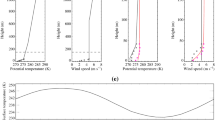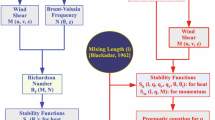Abstract
The current state-of-the-art general circulation models, including several of those used by the IPCC, show considerable biases in the simulated present day high-latitude climate compared to observations and reanalysis data. These biases are most pronounced during the winter season. We here employ ideal vertical profiles of temperature and wind from turbulence-resolving simulations to perform a priori studies of the first-order eddy-viscosity closure scheme employed in the ARPEGE/IFS model. This reveals that the coarse vertical resolution (31 layers) of the model cannot be expected to realistically resolve the Arctic stable boundary layer. The curvature of the Arctic inversion and thus also the vertical turbulent-exchange processes cannot be reproduced by the coarse vertical mesh employed. To investigate how turbulent vertical exchange processes in the Arctic boundary layer are represented by the model parameterization, a simulation with high vertical resolution (90 layers in total) in the lower troposphere is performed. Results from the model simulations are validated against data from the ERA-40 reanalysis. The dependence of the surface air temperature on surface winds, surface energy fluxes, free atmosphere stability and boundary layer height is investigated. The coarse-resolution run reveals considerable biases in these parameters, and in their physical relations to surface air temperature. In the simulation with fine vertical resolution, these biases are clearly reduced. The physical relation between governing parameters for the vertical turbulent-exchange processes improves in comparison with ERA-40 data.










Similar content being viewed by others
References
ACIA (2004) Arctic climate impact assessment. Cambridge University Press, Cambridge, pp 140
Arctic Climatology Project (2000) Environmental working group Arctic meteorology and climate atlas. In: Fetterer F, Radionov V (eds) Boulder (CD-ROM). National Snow and Ice Data Center, Colorado
Bazile E, Beffrey G, Joly M, Marzouki H (2005) Interactive mixing length and modifications of the exchange coefficient for the stable case. Newsletter ALADIN, Météo-France/CNRM/GMAP
Beare RJ, Macvean MK, Holtslag AAM, Cuxart J, Esau I, Golaz J-C, Jimenez MA, Khairoutdinov M, Kosovic B, Lewellen D, Lund TS, Lundquist JK, Mccabe A, Moene AF, Noh Y, Raasch S, Sullivan P (2006) An intercomparison of large-eddy simulations of the stable boundary layer. Boundary-Layer Meteorol 118(2):247–272
Beesley JA, Bretherton CS, Jakob C, Andreas EL, Intrieri JM, Uttal TA (2000) A comparison of cloud and boundary layer variables in the ECMWF forecast model with observations at surface heat budget of the Arctic Ocean (SHEBA) ice camp. J Geophys Res Atmos 105(D10):12337–12349
Beljaars A, Viterbo P (1999). The role of the boundary layer in a numerical weather prediction model. In: Holtslag AAM, Duynkerke PG (eds) Clear and cloudy boundary layers. Royal Netherlands Academy of Arts and Sciences, Netherlands, pp 287–304
Bossuet C, Deque M, Cariolle D (1998) Impact of a simple parameterization of convective gravity-wave drag in a stratosphere-troposphere general circulation model and its sensitivity to vertical resolution. Ann Geophys Atmos Hydrospheres Space Sci 16(2):238–249
Boville BA (1991) Sensitivity of simulated climate to model resolution. J Clim 4(5):469–485
Brandt T (2006) A priori tests on numerical errors in large eddy simulation using finite differences and explicit filtering. Int J Numer Methods Fluids 51(6):635–657
Bromwich DH, Wang S-H, Monaghan AJ (2002) ERA-40 representation of the arctic atmospheric moisture budget. ERA-40 Rep Ser 3:287–297
Bushell AC, Martin GM (1999) The impact of vertical resolution upon GCM simulations of marine stratocumulus. Clim Dyn 15(4):293–318
Chapman WL, Walsh JE (2007) Simulations of Arctic temperature and pressure by global coupled models. J Clim 20(4):609–632
Cuxart J, Holtslag AAM, Beare RJ, Bazile E, Beljaars A, Cheng A et al (2006) Single-column model intercomparison for a stably stratified atmospheric boundary layer. Boundary Layer Meteorol 118(2):273–303
Deque M, Dreveton C, Braun A, Cariolle D (1994) The Arpege/Ifs atmosphere model—a contribution to the French community climate modeling. Clim Dyn 10(4–5):249–266
Dethloff K, Abegg C, Rinke A, Hebestadt I, Romanov VF (2001) Sensitivity of Arctic climate simulations to different boundary-layer parameterizations in a regional climate model. Tellus Ser Dyn Meteorol Oceanogr 53(1):1–26
Esau I (2004) Simulation of Ekman boundary layers by large eddy model with dynamic mixed subfilter closure. Environ Fluid Mech 4(3):273–303
Francis J, Schweiger A (1999) TOVS Pathfinder Path-P daily Arctic gridded atmospheric parameters. National Snow and Ice Data Center, Boulder
Furevik T, Bentsen M, Drange H, Kindem IKT, Kvamsto NG, Sorteberg A (2003) Description and evaluation of the bergen climate model: ARPEGE coupled with MICOM. Clim Dyn 21(1):27–51
Geleyn J-F (1988) Interpolation of wind, temperature and humidity values from model levels to the height of measurement. Tellus Ser A Dyn Meteorol Oceanogr 40A:347–351
Gleckler P (1996) AMIP II Guidelines AMIP Newsletter No. 8, Program for Climate Model Diagnosis and Intercomparison: http://www-pcmdi.llnl.gov/projects/amip/NEWS/amipnl8
Hagemann S, Arpe K, Bengtsson L (2005) Validation of the hydrological cycle of ERA-40. ERA-40 Report, Series 24
Hogan TF, Brody LR (1993) Sensitivity studies of the navy’s global forecast model parameterizations and evaluation of improvements to NOGAPS. Mon Weather Rev 121:2373–2395
Hurrell JW (1995) Decadal trends in the North-Atlantic oscillation—regional temperatures and precipitation. Science 269(5224):676–679
Kalnay E, Kanamitsu M, Kistler R, Collins W, Deaven D, Gandin L et al (1996) The NCEP/NCAR 40-year reanalysis project. Bull Am Meteorol Soc 77(3):437–471
Key EL, Minnett PJ, Jones RA (2004) Cloud distributions over the coastal Arctic Ocean: surface-based and satellite observations. Atmos Res 72:57–88
Kiehl JT, Gent PR (2004) The community climate system model, version 2. J Clim 17(19):3666–3682
Lane DE, Somerville RCJ, Iacobellis SF (2000) Sensitivity of cloud and radiation parameterizations to changes in vertical resolution. J Clim 13(5):915–922
Liu YH, Key JR (2003) Detection and analysis of clear-sky, low-level atmospheric temperature inversions with MODIS. J Atmos Oceanic Technol 20(12):1727–1737
Louis JF (1979) Parametric model of vertical eddy fluxes in the atmosphere. Boundary Layer Meteorol 17(2):187–202
Mahrt L, Vickers D (2006) Extremely weak mixing in stable conditions. Boundary Layer Meteorol 119(1):19–39
Morcrette JJ (2002) The surface downward longwave radiation in the ECMWF forecast system. J Clim 15(14):1875–1892
Onogi K (2000) The long-term performance of the radiosonde observing system to be used in ERA-40. ERA-40 Rep Ser 2:77
Overland JE, Guest PS (1991) The Arctic snow and air-temperature budget over sea ice during winter. J Geophys Res Oceans 96(C3):4651–4662
Randall D, Shao Q, Branson M (1998) Representation of clear and coudy boundary layers in climate models. In: Holtslag AAM, Duynkerke PG (eds) Clear and coudy boundary layers. North Holland Publishers, Amsterdam, pp 305–322
Roeckner E, Brokopf R, Esch M, Giorgetta M, Hagemann S, Kornblueh L et al (2006) Sensitivity of simulated climate to horizontal and vertical resolution in the ECHAM5 atmosphere model. J Clim 19(16):3771–3791
Rossow WB, Schiffer RA (1999) Advances in Understanding Clouds from ISCCP. Bull Am Meteorol Soc 80(11):2261–2287
Ruti PM, Di Rocco D, Gualdi S (2006) Impact of increased vertical resolution on simulation of tropical climate. Theor Appl Clim 85(1–2):61–80
Simmons AJ, Burridge DM (1981) An energy and angular-momentum conserving vertical finite-difference scheme and hybrid vertical-coordinates. Mon Weather Rev 109(4):758–766
Slingo A, Hodges KI, Robinson GJ (2004) Simulation of the diurnal cycle in a climate model and its evaluation using data from Meteosat 7. Q J R Meteorol Soc 130(599):1449–1467
Smith TM, Reynolds RW (2004) Improved extended reconstruction of SST (1854–1997). J Clim 17(12):2466–2477
Tjernstrom M, Zagar M, Svensson G, Cassano JJ, Pfeifer S, Rinke A et al (2005) Modelling the arctic boundary layer: an evaluation of six arcmip regional-scale models using data from the Sheba project. Boundary Layer Meteorol 117(2):337–381
Tompkins AM, Emanuel KA (2000) The vertical resolution sensitivity of simulated equilibrium temperature and water-vapour profiles. Q J R Meteorol Soc 126(565):1219–1238
Troen I, Mahrt L (1986) A simple-model of the atmospheric boundary-layer—sensitivity to surface evaporation. Boundary Layer Meteorol 37(1–2):129–148
Uppala SM, Kallberg PW, Simmons AJ, Andrae U, Bechtold VD, Fiorino M et al (2005) The ERA-40 re-analysis. Q J R Meteorol Soc 131(612):2961–3012
Walsh JE, Kattsov VM, Chapman WL, Govorkova V, Pavlova T (2002) Comparison of Arctic climate simulations by uncoupled and coupled global models. J Clim 15(12):1429–1446
Zilitinkevich SS, Esau IN (2003) The effect of baroclinicity on the equilibrium depth of neutral and stable planetary boundary layers. Q J R Meteorol Soc 129(595):3339–3356
Zilitinkevich SS, Esau IN (2005) Resistance and heat-transfer laws for stable and neutral planetary boundary layers: old theory advanced and re-evaluated. Q J R Meteorol Soc 131(609):1863–1892
Acknowledgments
ECMWF ERA-40 data used in this study have been obtained from the ECMWF data server. This work has been supported by the Norwegian project MACESIZ 155945/700, joint Norwegian-USA project ROLARC 151456/720, and the PAACSIZ 178908/S30. This is publication number A 177 from the Bjerknes Centre for Climate Research. The authors whish to thank Dr. Martin Miles for valuable comments on the manuscript.
Author information
Authors and Affiliations
Corresponding author
Rights and permissions
About this article
Cite this article
Byrkjedal, Ø., Esau, I. & Kvamstø, N.G. Sensitivity of simulated wintertime Arctic atmosphere to vertical resolution in the ARPEGE/IFS model. Clim Dyn 30, 687–701 (2008). https://doi.org/10.1007/s00382-007-0316-z
Received:
Accepted:
Published:
Issue Date:
DOI: https://doi.org/10.1007/s00382-007-0316-z




